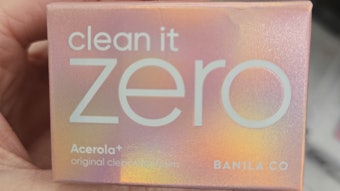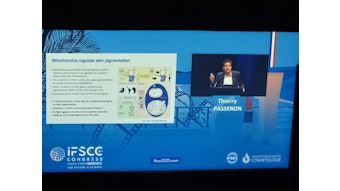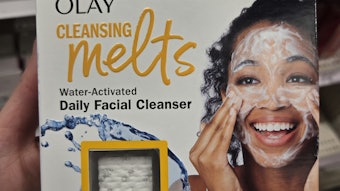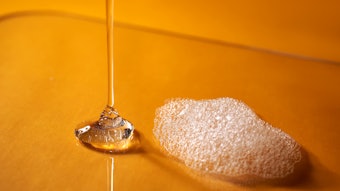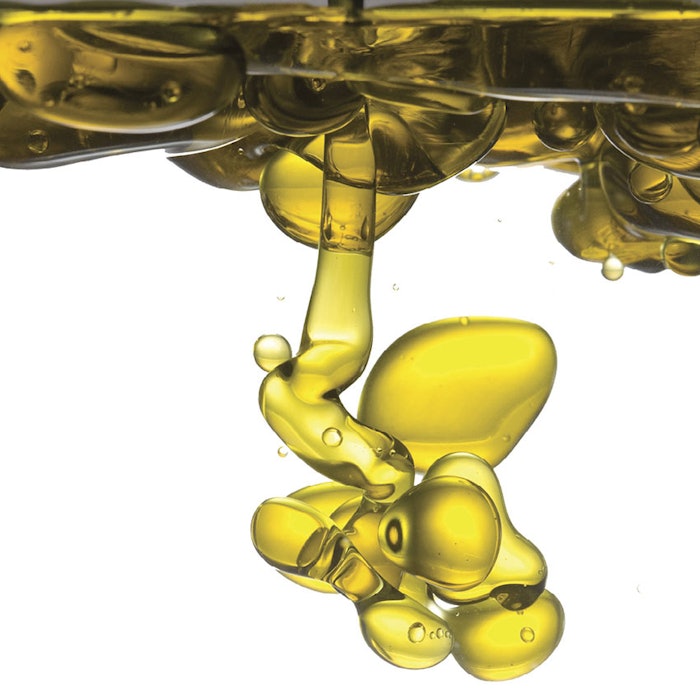
(Continued from Part I)
Pioneering Products
Cosmetics including deodorants, shampoo, skin care and perfumes are an integral part of daily life.54, 60 Today’s consumers perceive skin, hair and sun products a from a value-added perspective and are willing to pay for additional benefits.61-63 However, the cosmetic formulator cannot just make a standard formula and build on it. Appearance and feel must be considered, and formulations should provide long-term benefits to the consumer. Considering these requirements, microemulsions emerge as a tool for multiple benefits. They improve appearance, elegance and stability,64 are easy to apply, and useful to control the release of actives.65
Most importantly, due to the presence of polar, non-polar and interfacial domains, they enable the encapsulation of ingredients with varying solubility; for example, in cases where hydrophobic cosmetic actives might be drawn into the oil phase, making them difficult to dissolve into aqueous phases. Microemulsions therefore enhance the penetration of actives into the skin and pores.66 In fact, there has been a significant interest in the role of microemulsions as novel drug delivery systems, and even at selected lengths, along the intestinal track.67, 68
The following sections review more recent applications of microemulsions. Additionally, the delivery segment goes into greater depth and provides suggestions for optimization.
Microemulsion Moisturizers
The outermost stratum corneum is mainly concerned with barrier function. It is important to keep this layer flexible, which is achieved by controlling water content. Water content is intimately linked with the lamellae in the intracellular spaces of the stratum corneum. The drastic reduction of water levels leads to a dilation of the peripheral blood capillaries, leaving the skin dry, itchy and red. In addition, wrinkling and damage can compromise this layer and cause moisture loss.
Normally, moisturizing agents and active ingredients address these issues. However, moisturizing or nourishing solutions typically must be applied separately from other functions, e.g., cleansing, since it is challenging for products to provide all benefits at once. To overcome this limitation, microemulsions can be employed.69, 70
Microemulsions are more desirable than suspensions, dispersions or macroemulsions for several reasons. Emulsions are thick and tend to leave an oily patch on skin, which upon contact with external dirt, forms a greasy state and heavy, tacky feel. Microemulsion globules, due to their smaller size, penetrate the skin more deeply, effectively moisturizing while the aqueous phase washes away the dirt. Besides their delivery capabilities, microemulsions form a protective layer on skin that lasts for hours, they improve the flow of product across the skin, and they replenish natural skin oils. Lastly, they have a high level of clarity, which is esthetically pleasing for consumers.
Microemulsions also can improve the dispersions of some materials. For example, Parmer et al. produced stable neem oil-based microemulsions71 using alkyl phenolethyxolate as the nonionic emulsifier was nonionic. This invention was mainly appreciated for its alcohol-free formula, which is suitable for skin care and cure products.
Fine Dispersion Sprays
Microemulsions also can play a major role in sprays. Benner et al. proved it by making stable o/w, microemulsion-based sprays with inorganic pigments as emulsifiers.72 This is because microemulsions hold actives in a more finely dispersed form than simple emulsions so.
Slavetcheff et al. devised a hydroalcoholic microemulsion comprised of water, C4 alkanol, vitamin-based oils and terpenes73 to help impart water-insoluble vitamins and essential oils to the body. This form dries more quickly than solution-based formulas and gives a cooling sensation.
Baur et al. invented ester-based o/w micoremulsions with polyglycol ester as the emulsifier and another lipophilic internal phase. In this way, vitamins A, E, K, D and their derivatives could be dissolved in the lipophilic component and imparted to the skin74 to treat wrinkles, burns, etc.
Many others, such as Pereira et al., Wieshe, Sato, Yoshiki, etc., devised microemulsion-based cosmetic formulas that performed much better than corresponding emulsions or solutions.75-77 Doescher et al. prepared o/w microemulsions for cosmetic and dermatological light screening, which also turned out to be good bases for sprayable sunscreens or insect repellent.78 Ma et al. made stable, clear, antiperspirant microemulsions,79 and the Gillete Company made clear, silicon-based emulsions with water.80
Microemulsions can enhance the pentration of actives into the skin, thus their potential for drug delivery has gained interest.
How About in Hair?
Hair care products also have been reinvented using microemulsions. Compared with shampoos or oil-based products, microemulsions impart better effects in terms of combability, elasticity, styling, detangling and esthetics. Schroder et al., for example, produced highly viscous, gel-like microemulsions designed to keep the formula from dripping, allowing it time to act on the hair.81
Bergmann et al. synthesized a microemulsion based hair treatment that significantly improved the delivery of conditioning agents into hair,82 in turn improving wet and dry combing. It consisted of water-insoluble, amino-containing compounds containing silicone. This treatment is stable and is currently used in shampoos, conditioners, fixtures, lotions, hair sprays and more.
Since shampoos and styling agents normally make the hair and scalp dry, oil must be reapplied. However, microemulsions enable both oil nourishment as well as the removal of unwanted elements in one benefit system. Dow Corning Corp., for example, devised amino functional, silicone microemulsion-based clear shampoos;83 and Dalry et al. made transparent microemulsions for use in hair conditioners.84
Procter & Gamble also recently developed stable, microemulsion-based hair styling compositions that provide good style retention, restyling benefits and improved hair esthetics.85 These formulations were based on non-silicone hair styling polymer and a liquid hydrophilic non-polymeric cationic compound having at least one quaternary ammonium molecule. Likewise, numerous U.S. patents for hair bleaches and colorants incorporate microemulsions.86-88
Soothing Shaved Skin
Another area where microemulsions are effective is shaving lotions and foams, and after-shaves. The high amount of alcohol in these formulas typically is a source of irritation but microemulsion based formulas provide good pre-shaving lubrication through the oil phase. They also help to keep skin supple and wet after the shave.
Edwards et al., for example, prepared a polyorganosiloxane based microemulsion foam having a particle size of about 0.14 microns.89 This formulation improved the lubrication, richness and stability of the foam during shaving. It also gave good skin feel, anti-pore-clogging benefits and foam rinseability post-shaving.
Many others, e.g., Feng, Diec and Hill, developed miscellaneous microemulsion matrices for specific purposes.90-92 In fact, in Hill’s method, a clear, stable microemulsion was formed by combining water, a volatile cyclic methyl siloxane and a silicone polyether surfactant.
Peptide Transport
Besides the described areas, microemulsions are finding application in protein, peptide and drug delivery. As noted, microemulsions form a stable, feasible and pain-free method of delivery, as opposed to injections. Jones and coworkers assessed a radio-labelled anti-TNF receptor Fc-fusion protein applied to shaved skin via a w/o microemulsion, where it immediately was observed in the dermal layer. Thereafter, it shifted sidelong to distal areas of the skin and muscle.93 Many additional studies point to similarly interesting applications,94 the latest of which describes an all-inclusive microemulsion that can deliver a range of small peptides to large proteins (100-150,000 Da).
Drug Delivery
W/O drug delivery systems (DDSs) protect water-soluble moieties from the body’s metabolism.95 In microemulsion-based DDSs, these entities can be delivered into the target organ without being affected by metabolism or physical barriers.96, 97 Furthermore, they do not require high temperature processes, and hence are good for encapsulating heat-sensitive drugs. Such microemulsions normally are comprised of fatty acid esters as the oil phase and isopropanol as the co-surfactant.
The capability of microemulsion DDSs is exemplified in the delivery of vasopressin in rats.95 Using a microemulsion delivery base, researchers found the concentration of vasopressin delivered tripled that delivered by an aqueous base. In spite of such a prospect, however, DDSs have not gained industry response. The reasons may be a lack of knowledge of the intricate drug structures in solution, and the partition coefficient of the drug molecules between the oil and aqueous phase. The digestibility of the remnant oil is another question. Further research is being conducted to sort through these issues.98
Revealing Protein Processes
As per the work of Adachi et al.,99 dioctyl sodium sulfosuccinatea based w/o microemulsions are good media for the elucidation of proteins. The authors describe this approach as a phase transfer method, in which the impact of surfactant molecules on the adsorption of protein is studied. This adsorption is then related with time-dependent solubilization processes.
Hilhorst et al. inspected various aspects of enzyme and protein extraction using reverse micelles.100 Different theoretical models have been suggested, and conformational changes of proteins in both normal and reverse microemulsions of different charge types also have been reported.101-105
Another recent development is the pseudo phase model of microemulsion. This is used to quantitatively explain the diverse kinetic behavior of various amines. Gracia Rio et al. studied the shifting kinetics of the nitroso- group from (N-methyl-N-nitroso-p-toluene sulfonamide) to several amines, using varieties of water (and) dioctyl sodium sulfosuccinate (and) isooctane microemulsion basea.106
Researchers also used the pseudo phase model to explain the odd kinetics of solvolysis of many compounds. This is because the kinetics are better explained using steady state theory than normal second order kinetics.
Mediating Reactions
Microemulsions in gel also format can serve as a reaction medium. Reports suggest the use of lipase-containing microemulsion based gels to synthesize a variety of different esters on a lab scale under mild conditions.107-109 Both regio- and stereo-selective results have successfully been achieved.
It also has been found that microemulsions are the best media for biomimetic systems, assemblies and good models for highly conductive thin films and photosynthesis.110, 111 Nanoparticles, for example, often are manufactured by reverse microemulsion-based synthesis as it produces a much narrower particle size distribution.112, 113 Most bismuth oxyhalides are produced via microemulsion based routes, too. These compounds play a vital role in components of color filters, catalysis, electronics, etc.
Interestingly, the use of multiple microemulsions increases synthesis yield. In this, each reactant is dissolved in a separate vessel containing the same set of microemulsions. The nanoparticles are formed by intermicellar exchange of the reactants present in the separate reverse micelles. W/O microemulsions have a clear-cut advantage over other methods for preparing nanoparticle catalysts on supports, such as electron beam lithography, colloidal lithography and spin coating, as they can be formed at room temperature and pressure conditions.114
As Analytical Reagents
Finally, microemulsions have the potential to revolutionize the analytical aspects of chemistry in general and they are finding their way onto the shelves of chemical labs. The use of microemulsions as well as semi-microemulsions for the determination of metals has been reported.115-118 Furthermore, global studies have shown that microemulsion-based formulations greatly enhance spectro-analytical processes. They can be used as spectral-shifting agents, are good dissolving media and they amplify intensity.119
Microemulsion application even can extend to areas of laser excited photoionization spectroscopy.120 The latest advent in this field is microemulsion electro kinetic chromatography (MEEKC), which has been used to analyze the hydrophobicity of solutes.121, 122
Conclusions
Microemulsions present a means to convert the challenges faced by the industry into step-change opportunities. As a relatively recent discovery, microemulsions have grown and found importance in a variety of chemical and industrial processes. They enable the mixing of different phases and ingredients into single personal care formulas, they effectively deliver actives in a cost-efficient manner, and they can control the relative dispersion of formulas, e.g., in spray applications.
The field of microemulsions is far from being fully utilized, hence many researchers are continually intrigued by and challenged to exploit their immense potential in multiple areas. Microemulsions show exceptionally low interfacial tension, thermodynamic stability and giant interfacial area.123, 124 Thus, they provide the market with an opportunity for growth and many unique preparations.
References
- D Bancroft, Phys Chem, 1 414-425 (1897)
- W Clayton, The Theory of Emulsions and Their Technical Treatment, 4th, The Blakiston Co, Philadelphia (1943) p 1
- LM Prince, ed, Microemlusions: Theory and Practice, Academic Press, New York (1977)
- CE Cooke and J H Schulman, in Surface Chemistry (p. Ekwalled), Munksgaard, Copenhagen, Denmark (1965)
- PT Hoar and HJ Schulman, Nature (London) 152 p 102 (1943)
- AP Winsor, Hydrotropy, solubilization and related emulsification processes, Trans Faraday Soc 44 376-398 (1948)
- EK Bennett, TH Davis and EL Scriven, J Phys Chem 86 3917-3919 (1982)
- C Gonzalez et al, 6th International Symposium on Surfactants in Solutions, New Delhi, 258 (Aug 18-22, 1986)
- IS Ahmed, K Shinoda and S Friberg, J Colloid Interface Sci 47 32-37 (1974)
- HJ Schulman, W Stoeckentuis and ML Prince, J Phys Chem 63 1677-1680 (1959)
- ML Prince, J Soc Cosm Chem 21 193-204 (1970)
- IS Ahmed, K Shinoda and S Friberg, J Colloid Interface Sci 47 32-37 (1974)
- E Ruckenstein and R Krishnan, J Colloid Interface Sci 71 321-335 (1979)
- JThG Overbeck, PL deBruyn and F Vcrhoeckx, in Surfactants, ThF Tadros, ed, Academic Press (1985)
- G Gillberg, H Lehtinen and ES Friberg, J Colloid Interface Sci 33 40-53 (1970)
- I Danielsson and B Lindman, Colloid Surf 3 391-392 (1981)
- H Kunieda, H Asaoka and K Shinoda, J Phys Chem 92 185-189 (1988)
- M Allen, FD Evans, JD Mitchel and WB Ninham, J Phys Chem 91 2320-2324 (1987)
- JG Verhoeckx, LP de Bruyn and GThJ Overbeck, J Colloid Interface Sci 119 409-421 (1987)
- NR Healy, LR Reed and GD Stenmark, Eng J 16 147-160 (1976)
- D Senatra, J Electrostat 12 383-404 (1982)
- SE Friberg and YC Liang, Surfactant Sci Ser 24, MicroemulsionSystem103 (1987)
- C Solans et al, J Colloid Polym Sci 266 570-574 (1988)
- N Mitra, L Mukhopadhyay, PK Bhattacharya and SP Moulik, Indian J Biochem & Biophys 31(2) 115-120 (1994)
- SE Flores et al, Mini Reviews in Medicinal Chem 16(6) (2016)
- H Kunieda and K Shinoda, J Dispers Sci Tech 3 233-244 (1982)
- D Roux and M Bcllocq, in Physics of Ampiphilcs; Micelles, Vesicles and Microemulsions, V Digiorgio and M Corti, eds, North-Holland, Amsterdam (1985)
- RS Palit, AV Moghe and B Biswas, Trans Faraday Soc 55 463-476 (1959)
- M Rosoff, in Progress in Surface and Membrane Science,vol 12, DA Cadenhead and JF Danielli, eds, Academic Press, New York (1978) p 405
- LS Holt, J Disp Sci Tech 1 423-464 (1980)
- ID Robb, Microemulsions, Plenum Press, New York (1982)
- K Shinoda, ed, Solvent Properties of Surfactant Solutions, Marcel Dekker, New York (1967) ch 1, p 3
- WA Adamson, J Colloid Interface Sci 29 261-267 (1969)
- G Gillberg, H Lehtinen and ES Friberg, J Colloid Interface Sci 33 40-53 (1970)
- P Ekwall, L Mandell and K Fontell, J Colloid Interface Sci 33 215-235 (1970)
- K Shinoda and H Kunieda, J Colloid Interface Sci 42 381-387 (1973)
- ES Friberg and T Buraczenska, Prog Colloid Polym Sci 63 1-9 (1978)
- A-E Ahmed, AMA Makkya, MI Tadros, AA Alaa-Eldin et al, Eur J Pharma Sci 82(20) 31–44 (Jan 2016)
- K Shinoda and ES Friberg, Adv Colloid Interface Sci 4 281-300 (1975)
- E Sjoblom and ES Friberg, J Colloid Interface Sci 67 16-30 (1978)
- I Danielson and B Lindman, Colloids Surf 3 391-392 (1981)
- K Shinoda and B Lindman, Langmuir 3 135-149 (1987)
- M Kahlweit, Microemulsions Science 240 617-621 (1988)
- IDP Fletcher, FM Galal and HB Robinson, J Chem Soc Faraday Trans1 80 3307-3314 (1984)
- M Gautier et al, J Colloid Interface Sci112 484-487 (1986)
- JC Thater, T Sottmann and C Stubenrauch, Colloids and Surfaces A: Physicochemical and Engineering Aspects 494 139–146 (April 5, 2016)
- C Dai et al, Colloid and Polymer Science, 293(5) 1475–1481 (May 2015)
- DH Dorfier and E Nestler, Tcnside Surfactants Detergent 27 168-175 (1990)
- MJ Schick, Surfactant Science Series, Marcel Dekker, New York (1967)
- AJ O’Lenick, J Surfactants and Detergents 3 387-393 (2000)
- EJ Acosta, SK Kiran and CE Hammond, J Surfact and Detergents 15(4) 495–504 (July 2012)
- CE Hammond and EJ Acosta, J Surfact and Detergents 15(2) 157–165 (Mar 2012)
- S Ghosh and RT Johns, Soc Petroleum Engineers (2014)
- I Danielsson and B Lindman, Colloid Surf 3 391-392 (1981)
- Y Yuan, S-M Li, F-K Mo and D-F Zhong, Int J Pharm 321 117-123 (2006)
- US Pat 20067115565, assigned to P Gao and W Morozowich (2006)
- US Pat 20006054136, assigned to N Farah and J Denis (2000)
- M Kreilgaard, Adv Drug Delivery Rev 54 577-598 (2002)
- P Elena, S Paola and RG Maria, Int J Pharm 226 47-51 (2001)
- Y-S Rhee, J-G Choi, E-S Park and S-C Chi, Int J Pharm 228 161-170 (2001)
- RO and ML Francoeur ML, J Invest Dermatol 96 495-499 (1991)
- K Jung, M Seifert, Th Herrling and J Fuchs, Spectrochim Acta Part A (2008)
- US Pat 4797272, assigned to EE Linn and MP West (1989)
- S Norazlinaliza et al, RSC Adv 6 6234-6250 (2016)
- J Surfact and Detergents 19(1) 49–56 (Jan 2016)
- X Donga et al, Food Chem 192 1033–1040 (Feb 1, 2016)
- MR Patel, RB Patel, JR Parikh and BG Patel, Applied Nanoscience 6(4) 539–553 (Apr 2016)
- W He et al, Intl J Pharmaceutics 495(1, November 2015, pp 9-18) (Nov 2015)
- RO Potts and ML Francoeur, J Invest Dermatol 96 495-499 (1991)
- S Shafiq-un-Nabi et al, AAPS Pharm Sci Tech 8(2) E1-E6 (2007)
- US Pat 20046703034, assigned to BS Parmar, M Varshney and DO Shah (2004)
- US Pat 20046805871, assigned to G Benner, A Heptner and A Knuppel (2004)
- US Pat 5484597, assigned to CS Slavtcheff and SR Barrow (1996)
- US Pat 20026426078, assigned to K Bauer, C Neuber, A Schmid and KM Volker (2002)
- US Pat 20006117915, assigned to AG Pereira, P Obukowho, MG Garcia and N King (2000)
- US Pat 20056858216, Z Schulze, E Wiesche, D Hollenberg and B Bossmann (2005)
- JP Pat 7254346, assigned to S Yoshiki (2007)
- JP Pat 114661, assigned to A Doeschner and A Knueppel (2001)
- US Pat 20046790435, assigned to Z Ma and RM Brucks (2004)
- US Pat 20160151265 A1, assigned to T Doering and N Schevardo (2016)
- US Pat 5298240, assigned to F Schroder and G Lang (1994)
- US Pat 5077040, assigned to W Bergmann and J Bees (1991)
- US Pat US 5707613 A, assigned to RM Hill (1998)
- WO Pat 01056537, assigned to DM Dalrymple and M Manning (2001)
- US Pat 6149898 A, assigned to M Mossman, D Perry and E Kuhlman, P&G (1998)
- US Pat 9068150 B2, assigned to Gregory Van Burskirk, SL Cumberland, TW Kaaret and WL Smith, The Clorox Co (2015)
- US Pat 9133419 B2, assigned to C Wilker, SD McCormick and JM Lyle (2015)
- US Pat 2016006672 A1 (2016)
- US Pat 5523081, assigned to CJ Edwards and CW Jones (1996)
- US Pat 20066998424, assigned to QJ Feng, Z Lin and RM Hill (2006)
- US Pat 5705562, assigned to RM Hill (1998)
- US Pat 20036667044 , assigned to KH Diec, W Meier and J Schreiber (2003)
- R Jones and R Himes, Taylor & Francis 8(4) 537-546 (2011)
- YB Jamaloei, Recent Patents on Chemical Engineering, Bentham Science Publishers 2 1-10 (Jan 2009)
- AJ Owen, SH Yiv and A Sarkahian, Convertible Microemulsion Formation (Oct 29, 1992)
- AK Sharma, T Garg, A Goyal and G Rath, Artifical Cells, Nanomedicine and Biotechnology 44(4) 1177-1185 (2015)
- S Talegaonkar and LM Negi, Advances in Delivery Science and Technology 433-459 (2015)
- X Wang, H Chen, Z Luo and X Fu, Carbohydrate Polymers 138 192-200 (Mar 15, 2016)
- M Adachi and M Harada, Phys Chem 97 3631-3640 (1993)
- R Hilhorst et al, Pure and Appl Chem 64 1765-1770 (1992)
- M Dekker, KV Riet, BH Bijsterbosh, P Fijneman and R Hillhorst, Chemical Egr Sci 45(9) 2949-2957 (1990)
- M Dekker, R Hillhorst and C Laane, Analytical Biochemistry (1989)
- BG Mazi, H Hamamci, DM Ogrydziak and SR Dungan, Applied Biochem and Biotech 1-16 (Jun 2016)
- S Sadeghi, A Madadlou and M Yarmand, Food Hydrocolloids 35 590-596 (Mar 2014)
- AA Rigi and S Abbasi, Food Chem 197, part A 1002-1007 (Apr 2016)
- L Garcia-Rio, RJ Leis, EM Pena and E Iglesias, J Phys Chem 97 3437-3442 (1993)
- J Bedia et al, Colloids and Surfaces A: Physiochemical and Engineering Aspects 469 202-210 (Mar 2015)
- P Ghosh et al, J Surface Sci and Tech 32(1-2) 8-16 (Jun 2016)
- X Yu, Q Li, M Wang, Na Du and X Huang, Soft Matter 1713-1720 (2016)
- DG Rees et al, Ind J. Chem 32B 30-34 (1993)
- S Backlund, F Ericksson, TL Kanerva and M Rantala, Colloids Surf 4B 121-127 (1995)
- J Henle, Chem Mater 366-373 (2007)
- JA Wang, Today 68 21-30 (2001)
- RG Jones and R Himes, Expert Opin Drug Deliv 8 537-546 (2011)
- Y Zheng, L Fyang, Y Yan, S Lin, Z Liu and Y Yang, Separation and Purification Technology 169 289-295 (Sep 2016)
- PO Vicentino and RJ Cassella, Talanta 162 249-255 (anticipated Jan 2017)
- CC Leite, AV Zimozinski M Goreti and MM Silva, Analytical Methods 7 3363-3371 (2015)
- A Pirogov, L Sokolova, E Sokerina, O Tataurova and O Shpigun, Journal of Liquid Chrom and Related Tech 39(4) 220-224 (2016)
- RE Hoffman, E Darmon, A Aserin and N Garti, Colloids and Surfaces A, Physiochemical Engineering Aspects 507 218-226 (Oct 2016)
- K Li, M Wang, J Wang, R Zhu, D Sun, X Sun and SL Wang, Photochemistry and Photobiology 89(1) 61-67 (2013)
- T Bin, G Dan, Lin Xia, Y Jin, Y Hongquin and Li Hui, Current Pharmaceutical Analysis 11(3) 224-230 (2015)
- CW Chang, YC Chen and CY Liu, Electrophoresis 36, issue 21-22 2745-2753 (Nov 2015)
- http://cdn.intechopen.com/pdfs/32548.pdf (Accessed Nov 7, 2016)
- https://books.google.com/books?hl=en&lr=&id=ML1NvSQPd4kC&oi=fnd&pg=PR3&dq=industrial+Applications+of+Microemulsions,+Surfactant+science+series&ots=ljrXFj8DUL&sig=lWP3uGbZ1jcW98tSFDM89h1BIEg (Accessed Nov 7, 2016)

